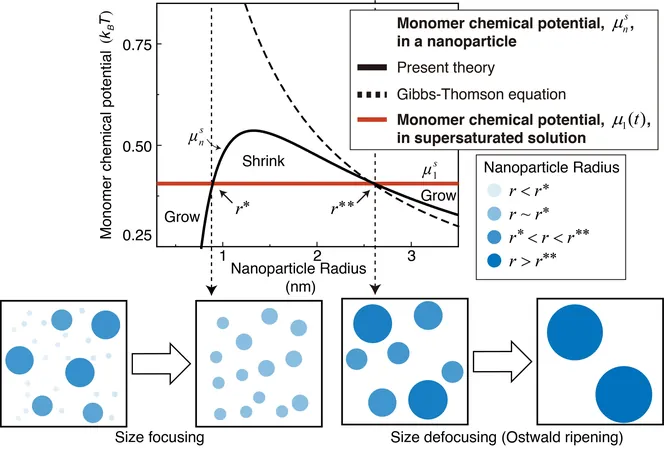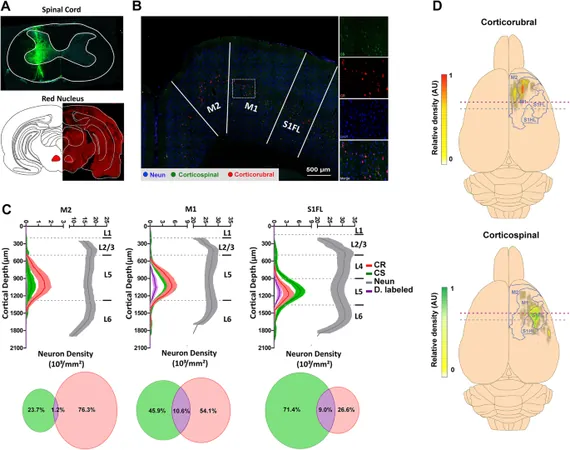
Revolutionary Discovery: New Model of Nanoparticle Formation Shatters Century-Old Beliefs!
2025-08-28
Author: Li
Unlocking the Secrets of Nanoparticles
Nanoparticles are at the forefront of scientific innovation, driving advancements in quantum-dot displays, nanocatalysts, and efficient drug delivery systems. Their customizable physicochemical properties make them incredibly valuable in various applications.
The Flaws in Classical Nucleation Theory
Despite years of research, how uniformly sized (monodisperse) nanoparticles actually form remains a mystery. The classical nucleation theory (CNT) has been the go-to explanation for over a hundred years, but it fails to elucidate why these nanoparticles settle into consistent size ranges.
A Breakthrough Study That's Changing the Game
A groundbreaking study led by Professor Jaeyoung Sung from Chung-Ang University has introduced a revolutionary new model that explains the complex growth dynamics of nanoparticle ensembles. This research, published in the Proceedings of the National Academy of Sciences, could change everything we thought we knew about nanoparticle formation.
Real-Time Observations Break New Ground
The team utilized advanced liquid-phase transmission electron microscopy (TEM) to observe the real-time growth of hundreds of colloidal nanoparticles. These observations revealed that particle growth is anything but straightforward—it is influenced by multiple kinetic phases, characterized by significant variations in nanoparticle size and growth dynamics.
From Complexity to Clarity: A New Theory Emerges
This innovative model incorporates six crucial characteristics affecting nanoparticle growth, including energy, shape, and interaction with surrounding molecules. By accounting for the complex behaviors of nanoparticles—such as their translation, rotation, and vibration—the new theory offers profound insights that directly challenge previous models.
A New Perspective on Size Dynamics
One intriguing prediction from this new theory suggests that smaller nanoparticles can actually grow while larger ones dissolve, defying the traditional Ostwald ripening theory. This challenges long-held beliefs and sheds light on how nanoparticles achieve uniform size distributions.
Applications Beyond Nanoparticles
But the implications of this research extend far beyond nanoparticles. Professor Sung notes that this general theory could help explain the formation and aggregation of biological condensates, which are relevant in neurodegenerative diseases like Alzheimer's.
A Future of Predictable Nanoparticle Synthesis
The combination of this new theoretical framework with advances in artificial intelligence paves the way for predictable nanoparticle synthesis. This could revolutionize fields like catalyst design, semiconductor manufacturing, and personalized medicine.
Conclusion: A New Era in Nanoparticle Research
With this breakthrough, the future of nanoparticle research is brighter than ever. Understanding how to tailor nanoparticles with precision will open new avenues in science and industry, representing a paradigm shift in how we approach nanoparticle technology.



 Brasil (PT)
Brasil (PT)
 Canada (EN)
Canada (EN)
 Chile (ES)
Chile (ES)
 Česko (CS)
Česko (CS)
 대한민국 (KO)
대한민국 (KO)
 España (ES)
España (ES)
 France (FR)
France (FR)
 Hong Kong (EN)
Hong Kong (EN)
 Italia (IT)
Italia (IT)
 日本 (JA)
日本 (JA)
 Magyarország (HU)
Magyarország (HU)
 Norge (NO)
Norge (NO)
 Polska (PL)
Polska (PL)
 Schweiz (DE)
Schweiz (DE)
 Singapore (EN)
Singapore (EN)
 Sverige (SV)
Sverige (SV)
 Suomi (FI)
Suomi (FI)
 Türkiye (TR)
Türkiye (TR)
 الإمارات العربية المتحدة (AR)
الإمارات العربية المتحدة (AR)